|
Lawrence
Totaro noted some references to Chess and composer/artist John Cage within
the book, Conversing with Cage
Conversing with Cage. Contributors: Richard Kostelanetz -
author. Publisher: Routledge. Place of Publication: New York. Publication Year:
2003.
Page 5
Schoenberg was approaching sixty when I became one of his
students in 1933. At the time what one did was to choose between Stravinsky
and Schoenberg. So, after studying for two years with his first American
student, Adolph Weiss, I went to see him in Los Angeles. He said, “You
probably can’t afford my price, ” and I said, “You don’t need to mention it
because I don’t have any money. ” So he said, “Will you devote your life to
music?” and I said I would. And though people might feel, because I know my
work is controversial, that I have not devoted myself to music utterly, that I
have spent too much time with chess, or with mushrooms, or writing, I still
think I’ve remained faithful. You can stay with music while you’re hunting
mushrooms. It’s a curious idea perhaps, but a mushroom grows for such a short
time and if you happen to come across it when it’s fresh it’s like coming upon
a sound which also lives a short time. —Jeff Goldberg (1976)
Page 12
To continue with Duchamp a bit: Was he a good chess teacher?
I was using chess as a pretext to be with him. I didn’t learn, unfortunately,
while he was alive to play well. I play better now, although I still don’t
play very well. But I play well enough now that he would be pleased, if he
knew that I was playing better. So that when he would instruct me in chess,
rather than thinking about it in terms of chess, I thought about it in terms
of Oriental thought. Also he said, for instance, don’t just play your side of
the game, play both sides. That’s a brilliant remark and something people
spend their lives trying to learn—not just in chess, but everything. —Paul
Cummings (1974)
Page 18
Why do you have such a strong interest in chess, which is a
rigid, closed system?
In order to let it act as a balance to my interest in chance. I think the same
thing is true of Marcel Duchamp. Because when he gave me his book on chess, I
asked him to write something in it, and he wrote in French : “Dear John, Look
out, still one more poisonous mushroom. ” Because both mushrooms and chess,
you see, are the opposite of chance operations. —Art Lange (1977)
[Chess] is pretty directed then?
Yes. On the other hand, I like games anyway. I even like poker. I don’t play
it very often. Sometimes if you get in residence at a university you have to
play games with the teachers. Poker is very popular at universities. —Mark
Bloch (1987)
I spend most of the day working. Sometimes I interrupt my work to go mushroom
hunting or to play chess, which I don’t have a gift for. Marcel Duchamp once
watched me playing and became indignant when I didn’t win. He accused me of
not wanting to win. You must have an extraordinary aggressiveness to play
well. —Jeff Goldberg (1976)
Page 32
So you don’t have any real secrets about how you manage all
this?
Well, you begin by watering the plants, and you end the day by playing chess.
And I have to do my exercises. And I shop, generally, though I didn’t do that
today.
So by having a game of chess at the end of the day…
I’m making a balance with my use of chance operations. Because if I make a
wrong move with my knight, I lose. Games are very serious success-and-failure
situations, whereas the use of chance operations is very free of concern. It’s
like being enlightened. —Kathleen Burch et al. (1986)
Page 185
Later, it must have been in the early sixties, it just
happened that one holiday season between Christmas and New Year’s, when there
are so many parties in New York, we happened to be invited to the same
parties. Suddenly, I saw him every night, four nights in a row; and I noticed
there was a beauty about his face that one associates, say, with coming death
or, say, with a Velásquez painting. And I realized suddenly that I was foolish
not to be with him, and that there was little time left. And so I said to
Teeny [Mme. Duchamp], “Do you think Marcel would be willing to teach me to
play chess?” Because I knew that that would be a way to be with him without
asking him questions; or if I asked him questions, they would be ones it would
be useful to know the answers to. And so she said, “Why don’t you ask him
yourself. ” So I went up to him and said, “Would you teach me chess?” And he
said, “Do you know the moves; do you know how the pieces move?” And I said,
“Yes, I know that”; and he said yes. And so we made an appointment, then, for
me to go to his house; and after that, we were together as often as possible,
at least once a week when they were in New York, or sometimes twice a week.
—Alain Jouffroy and Robert Cordier (1974)
Page 214-215
My two closest friends among [visual] artists are [Robert]
Rauschenberg and [Jasper] Johns. And I knew many of the other painters, but my
kind of family attachment is to Rauschenberg and Johns. And then I always
admired Duchamp so much that I couldn’t speak straight and about four or five
years ago, I asked him to teach me chess, so I often was with him in his last
years, and I love his work very much. Originally, I had liked abstract
painting, and particularly Mondrian. And then it was Rauschenberg who opened
my eyes to the possibility of something that wasn’t abstract and then it’s
been so interesting because it was then Johns. I see Johns now more than any
of the others. I like, let’s see, of the ones since then, I think Claes
Oldenburg. —Don Finegan et al. (1969)
Page 219
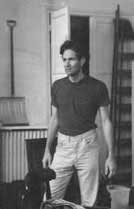
[The conceptual artist William Anastasi, whose career began in
the early 60s, is probably best known for playing chess with John Cage everyday
in the late 70's.]
[Bill] Anastasi?
We play chess every day. We’re going to play today, and he’ll either drive
down or he’ll take the subway. If he comes down the subway, he’ll bring
headphones without music, and papers and a board to draw on, and pencils and
so forth; and he’ll make a drawing with his eyes closed, and his arms
responding to the movement of the subway car. —Richard Kostelanetz (1991)
What can you say about John Cage?
A revolutionary composer, just as his friend Marcel Duchamp was
a revolutionary artist, he was also, like Duchamp, an artist and a chess-player.
It's difficult to explore Cage's chess connection without including Duchamp.
Chessbase featured an interview with Prof. Enrique Irazoqui, "An economist
and a professor of literature, he is also an expert in information technology
and artificial intelligence. For many years he edited a magazine on computer
chess – in the end in electronic form. He always loved chess and has played
against Marcel Duchamp, who was a master class chess player." Prof. Irazoqui
lives in Cadaqués, which was also the home to famous artists, writers and
intellectuals such as Picasso, Miro, Duchamp, Cage and Dalí, who "during all
this time, in the cafes next to the sea, they played chess."
When asked about his chess associations with Duchamp and Cage, he responded:
How was it to play with Duchamp?
For me it was a pleasure but I am not sure it did him very
well. He usually finished being very upset. Teeny, his wife, asked me not to
play him any more because he would not sleep after that. It was tender, on a
way, very fragile. After that I mainly played with Teeny.
And John Cage?
He used to ask Raymond Keene to teach him how to defeat
Duchamp, but he never made it. I remember one day we were playing as usual,
in the Café, and he placed a pentagram of thin translucent paper on the
windows. He drew one note on top of each star and composed a melody of the
night. Fortunately I never heard it, but this gives you an idea of how were
these people and these days
The PBS American Masters Series claimed:
Many of Cage's ideas about what music could be were inspired
by Marcel Duchamp, who revolutionized twentieth-century art by presenting
everyday, unadulterated objects in museum settings as finished works of art,
which were called "found art," or ready-mades by later scholars. Like Duchamp,
Cage found music around him and did not necessarily rely on expressing
something from within.
Marcel Duchamp and John Cage appear in a 1972 movie by that name. The linked
page offers this description:
PLOT DESCRIPTION
"Marcel Duchamp and John Cage" is both a document of a chess game and an
unusual theory on the nature of art. While Duchamp and Cage play chess,
Duchamp is filming the match according to a semi-random program of camera
placement, focus setting, and length of shot. The film is constructed like one
of Cage's musical compositions, and he talks at length about his esthetic
philosophies as well. ~ John Voorhees, All Movie Guide
In 1944, Cage created a painting titled Chess Pieces that
contains a music. John Cage had been invited to participate in
The Imagery of Chess exhibition at the Julien Levy Gallery in New York
City ( along with such artists as Alexander Calder, Isamu Noguchi, Robert
Motherwell, André Breton, Marcel Duchamp, Max Ernst, Man Ray, Dorothea Tanning)
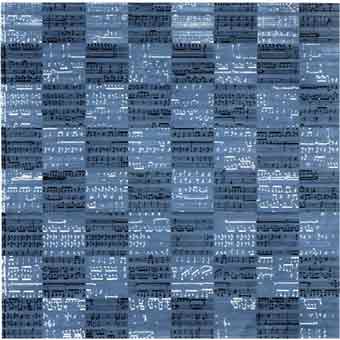
The music, interpreted by Margaret Leng Tan, is available
on the album, John Cage: The Works for Piano 7
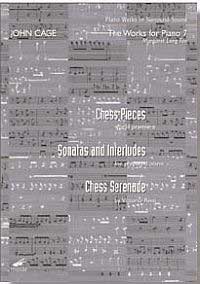
Margaret Leng Tan, who worked with Cage for 12 years and
who performed the piano music on the album wrote, "There are 22 systems of
music, each 12 bars long and self-contained. So what you have are 22 little
'chess pieces,"
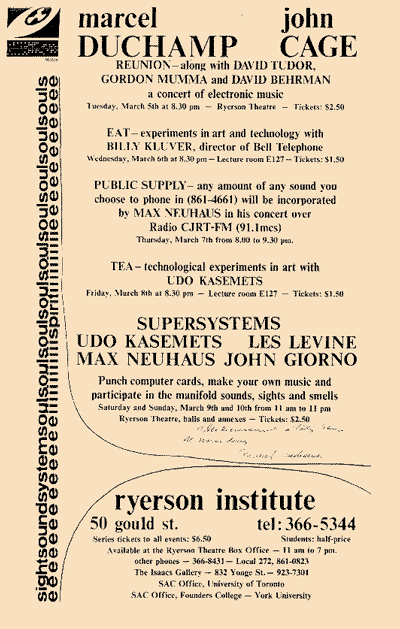
Reunión
Somewhere between Dream and Reality by Ya-Ling Chin explains:
Performed at Ryerson Theatre of Ryerson Polytechnic, Toronto, on
March 5, 1968, Reunion was organized by John Cage and included the musicians
David Tudor, Gordon Mumma, and David Behrman and a wired-up chessboard designed
by Lowell Cross (Fig. 3). When Teeny and Marcel Duchamp took turns playing chess
with Cage on the stage, the pre-modulated photoreceptors served as a gating
mechanism to receive messages of movements and to transmit sound and light.
Depending on the moves of the chess pieces, the sound was cut off or rerouted to
generate a kind of random music by means of the pre-configured chance operation
of two "intellectual minds."
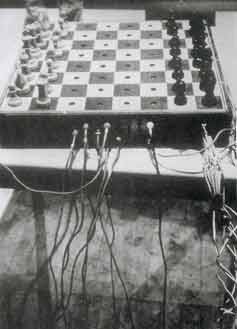
Lowell Crass had constructed a chess board with circuits; moves on the board
transmitted or cut off sound produced by several musicians.
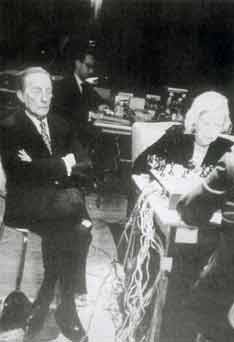
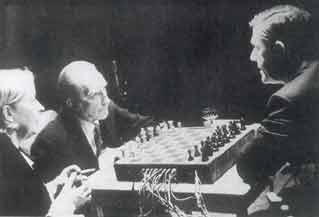
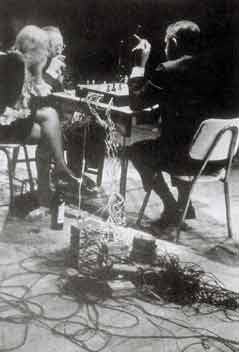
From
John Cage - An Autobiographical Statement :
I was invited by Irwin Hollander to make lithographs. Actually
it was an idea Alice Weston had (Duchamp had died. I had been asked to say
something about him. Jasper Johns was also asked to do this. He said, "I don't
want to say anything about Marcel." I made Not Wanting to Say Anything About
Marcel: eight plexigrams and two lithographs. Whether this brought about the
invitation or not, I do not know.
From
Painting a picture of a creative partnership by Susan Mansfield :
Cage would say later that he had enjoyed both music and visual
art as a student, but that Schoenberg, under whom he studied in LA,
forced him to choose between them. "He said that if he wanted to be a
composer, he had to choose only music, which he did," says Miguel. "He didn't
make visual work for about 30 years."
However, in 1969, he made Not Wanting To Say Anything About Marcel, a work
using Plexiglas, as a response to the death of Marcel Duchamp. "He was in a
taxi with Jasper Johns and they were both asked to say something about
Duchamp, who had just died," says Miguel. "Neither of them wanted to say
anything, because nothing would have been enough.
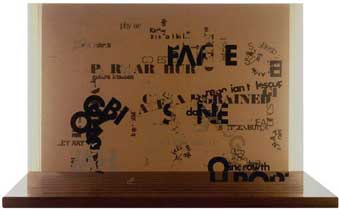
Not Wanting To Say Anything About Marcel, I, 1969
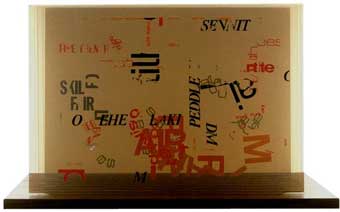
Not Wanting To Say Anything About Marcel, II, 1969
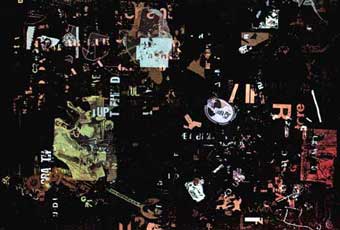
"Not Wanting to Say Anything About Marcel", 1969, "Lithograph B"
From
The Page is Not a Neutral Surface by poetess Jessica Smith :
John Cage’s Not Wanting to Say Anything about Marcel. A
stack of page-like glass rectangles, Not Wanting allows words to
fragment and accumulate in turn—depending, in some cases, on the reader’s
physical relation to the stack—and never allows one to take for granted any
unit of meaning. No phrases exist. Words fracture. Partial letters slip into
the murk of transparency. In the flatness of the pictures included in the
Poetry Plastique exhibition catalog (Granary Press), one can see or imagine
the three-dimensionality of the object, which itself takes advantage of all
three dimensions to allow words to hide behind each other or escape from their
strata depending on the viewpoint of the
reader.
After all, what can you say about John Cage? |

